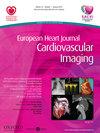Global longitudinal strain in patients with severe aortic stenosis: a comparison between cardiac magnetic resonance imaging feature tracking and speckle tracking echocardiography
引用次数: 0
Abstract
Type of funding sources: None. Global longitudinal strain (GLS) by echocardiography is a sensitive method for measuring left ventricular (LV) function, and of better prognostic value in valvular heart disease than ejection fraction (EF). Cardiac magnetic resonance imaging (CMR) is the most accurate method for measuring LV volume and EF, but GLS has not been possible to measure by CMR until recently. This study compares GLS obtained by CMR and echocardiography in patients with severe aortic valve stenosis. Normal values for GLS by CMR are reported as well. GLS was measured in 32 patients with severe aortic valve stenosis with speckle tracking echocardiography, using GE Vivid E95 (n = 15) and Philips EPIQ (n = 17) ultrasound machines, as well as with CMR (Avanto 1.5T FIT, Siemens Medical Solutions). For normal values, GLS was measured by CMR in 9 healthy controls. Endo- and epicardial borders of two, three and four chamber cine images were traced for CMR GLS using dedicated software (Qstrain 2.0, Medis, NL). Both CMR and Vivid E95 measured midmyocardial strain, whereas the EPIQ AutoStrain method measures endomyocardial strain. Absolute values of GLS are reported. Pearson correlation coefficient was calculated and paired Student’s t-test was used for comparisons. A significant correlation (r = 0.45, p = 0.01) was found between echocardiographic and CMR GLS (Figure). GLS by Vivid E95 had a very good correlation with CMR GLS (r = 0.84, p = 0.0001), whereas GLS by Philips EPIQ did not correlate significantly (r = 0.14, p = 0.01). In patients with aortic stenosis and healthy controls, the average GLS by CMR was 18.3 ± 3% and 20.9 ± 2% respectively. The average GLS by CMR was comparable to that obtained by GE Vivid E95 (17.3 ± 4% vs. 17.2 ± 3%, p = 0.92), and higher than by Philips EPIQ (19.2 ± 2% vs. 15.4 ± 2%, p < 0.0001). This study shows that GLS by CMR is feasible and correlates with GLS obtained by echocardiography, especially when quantifying midmyocardial strain. Echocardiographic GLS values based on endomyocardial strain were lower. Patient characteristics Age 75 ± 14 y NYHA 1 1 (3 %) NYHA 2 20 (67 %) NYHA 3 8 (27 %) NYHA 4 1 (3 %) CMR EF 66 ± 8 % AVA 0.7 ± 0.2 cm² NYHA = NYHA class of symptoms, EF = ejection fraction by CMR, AVA = aortic valve area by echocardiography Abstract Figure. GLS by CMR vs. Echocardiography严重主动脉瓣狭窄患者的整体纵向应变:心脏磁共振成像特征跟踪与斑点跟踪超声心动图的比较
资金来源类型:无。超声心动图总纵应变(GLS)是一种灵敏的左室功能测量方法,在瓣膜性心脏病中比射血分数(EF)有更好的预后价值。心脏磁共振成像(CMR)是测量左室容积和EF最准确的方法,但直到最近才有可能通过CMR测量GLS。本研究比较了CMR和超声心动图在重度主动脉瓣狭窄患者中的GLS。同时也报告了CMR测量GLS的正常值。采用斑点跟踪超声心动图测量32例重度主动脉瓣狭窄患者的GLS,使用GE Vivid E95 (n = 15)和Philips EPIQ (n = 17)超声仪以及CMR (Avanto 1.5T FIT, Siemens Medical Solutions)。对于正常值,用CMR测量9例健康对照的GLS。使用专用软件(Qstrain 2.0, Medis, NL)追踪CMR GLS的二室、三室和四室电影图像的内腔和心外膜边界。CMR和Vivid E95均测量心肌中应变,而EPIQ AutoStrain法测量心内膜应变。报告了GLS的绝对值。计算Pearson相关系数,采用配对Student’s t检验进行比较。超声心动图与CMR GLS之间存在显著相关性(r = 0.45, p = 0.01)(图)。Vivid E95的GLS与CMR GLS有很好的相关性(r = 0.84, p = 0.0001),而Philips EPIQ的GLS无显著相关性(r = 0.14, p = 0.01)。在主动脉瓣狭窄患者和健康对照组中,CMR平均GLS分别为18.3±3%和20.9±2%。CMR的平均GLS与GE Vivid E95相当(17.3±4%比17.2±3%,p = 0.92),高于Philips EPIQ(19.2±2%比15.4±2%,p < 0.0001)。本研究表明CMR测定GLS是可行的,且与超声心动图测定GLS有相关性,尤其是在定量心肌中应变时。基于心内膜肌张力的超声心动图GLS值较低。患者特征年龄75±14岁NYHA 1 1 (3%) NYHA 2 20 (67%) NYHA 3 8 (27%) NYHA 4 1 (3%) CMR EF 66±8% AVA 0.7±0.2 cm²NYHA = NYHA症状分类,CMR EF =射血分数,超声心动图AVA =主动脉瓣面积。CMR与超声心动图GLS比较
本文章由计算机程序翻译,如有差异,请以英文原文为准。
求助全文
约1分钟内获得全文
求助全文

 求助内容:
求助内容: 应助结果提醒方式:
应助结果提醒方式:


